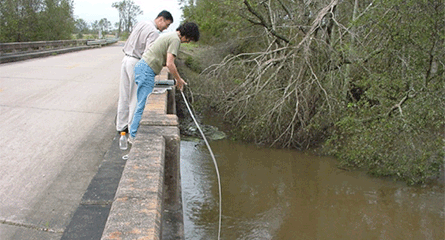Dr. Durga Poudel, assistant director of the School of Geosciences at UL Lafayette, grew up in a small community in the mid-hill region of Nepal, tending buffalo, goats, crops and fruit with his younger brother.
His father, who had served in the British Army, farmed a plot of land that he had settled in the years after World War II. His mother, who served the family’s meals, worried a lot, Poudel said, particularly during monsoon season. That’s when heavy rains tore the family’s food supply from the ground and washed it away.
The experiences him led him to study agriculture, natural resources and soil science at universities in Nepal, Pakistan, Thailand and the United States. He began his career with the Nepalese Ministry of Agriculture.
“Seeing so much erosion when I was growing up is what formed my interest in soil and water conservation,” said the 52-year-old professor, researcher and director.
Poudel joined the University in 2000, after spending two years overseeing a sustainable farming system at the University of California-Davis.
Today, he’s regarded an international expert in soil and water conservation, water quality, climate change and sustainability.
Poudel will speak about the issues at the International Grassland Congress on Sept. 15 in Sydney, Australia.
“Soil and water quality are major environmental issues everywhere in the world,” he said.
In Louisiana, Poudel led a team of researchers who conducted a six-year study to measure how agricultural production impacts water quality along the Bayou Plaquemine Brule Watershed.
Results were outlined in a 17-page article published in the May/June 2013 issue of the Journal of Soil and Water Conservation.
The findings illustrated how agricultural practices cause nonpoint source pollution, or pollution for which the origin is unknown or unclear, Poudel said.
The Bayou Plaquemine Brule Watershed has been on Louisiana’s list of impaired water bodies, or those that don’t meet state water quality standards, since 1998. The about 55-mile watershed flows through the Mermentau River Basin in southwestern Louisiana.
The United States Environmental Protection Agency and the Louisiana Department of Environmental Quality funded the project.
Poudel led a research team who collected surface water samples every 15 days between 2002 and 2008 to gauge the impact of agricultural production on water quality.
The samples were taken at seven spots along an about 20-mile stretch of the Bayou Plaquemine Watershed.
Computer models were used to identify nonpoint source pollution “hotspots” in the watershed. Water quality data such as surface water temperature, dissolved oxygen levels, biological oxygen demand, the presence of nutrients and chemicals, and pH levels were analyzed.
“The idea was to determine how water quality differs from season to season, and what are the factors that cause differences in water quality. After we determined that, we wanted to find hotspots, the major areas with nonpoint source pollution,” Poudel said.
Sediment, nutrients and dissolved solids were key factors that impacted water quality.
“The lower part of the watershed was worse because of agricultural practices in rice and crawfish production,” Poudel said.
In Nepal, Poudel led another team on an 18-month project that began in 2011.
The goal of the Nepal study was to research water availability, soil quality and disease in an effort to improve livestock health and agricultural productivity for more than 350 households on the Thulokhola watershed in the nation’s mid-hill region.
For that project, Poudel used many of the same techniques, analysis and computer models that had been used in Louisiana.
The Nepal project was funded by the Livestock Climate Change Collaborative Research Support Program at Colorado State University and sponsored by the United States Agency for International Development.
The 18-month project ended earlier this year.
In Nepal, more than 23 million people, or about 80 percent of the population, depend on agriculture for their livelihood, Poudel said. The quantity of drinking water in Nepal is critical since climate changes are drying up water sources.
Results from such studies are useful in developing sound conservation plans and land management techniques.
Subsequent training and workshops were held to help Nepalese farmers learn how to monitor water quality, keep records and vaccinate livestock herds.
Since the training, the presence of gastrointestinal parasites in the region’s goats has decreased by 70 percent.
“Pinpointing causes of degraded water quality and isolating hotspots helps government or industry focus resources to help improve water quality in critical areas,” Poudel said.
